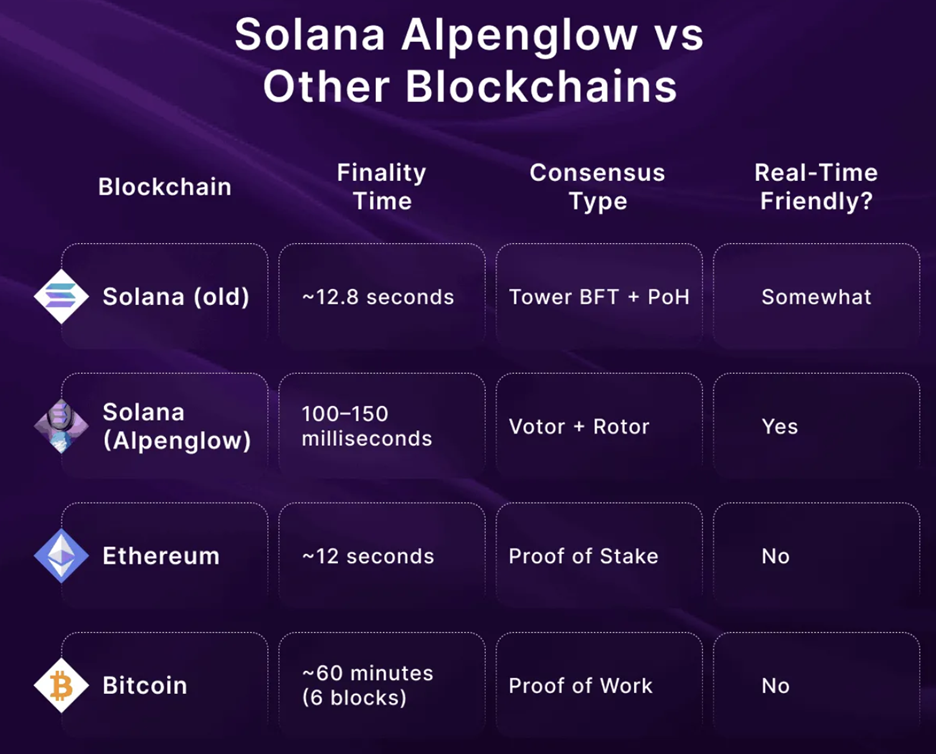 |
| By Marija Matic |
Right now, most people interested in crypto are staring at charts.
But if that’s all you’re watching, you may miss what’s coming next.
Because behind the scenes, Solana (SOL, “B”) is gearing up for what could be the most ambitious change in its history — a decision that could redefine how fast and decentralized a blockchain can be.
The proposal is called Alpenglow (SIMD-0326). And if passed, it would shrink Solana’s transaction finality from a couple of seconds down to fractions of a second.
That means transactions could be processed literally faster than the blink of an eye.
Why Alpenglow Feels Like a Moonshot
Imagine sending money, trading an NFT or playing a blockchain game where confirmation feels as instant as refreshing your Instagram feed.
That’s the promise, at least.
Right now, Solana finalizes transactions in about 2–3 seconds. That’s already lightning fast compared to Ethereum (ETH, “A-”), which takes minutes. Or Bitcoin (BTC, “A-”), which takes hours.
But Alpenglow, in theory, could be even faster than chains like Sui (SUI, “B”), which typically finalizes in about 1 second.
Alpenglow wants to cut Solana’s finality down to 100–150 milliseconds.

To put that in perspective: that’s about the time it takes for you to blink.
If it works, Solana apps could feel less like “using a blockchain” and more like “using the internet.”
Trading on a decentralized exchange could feel as smooth as Robinhood. Multiplayer blockchain games could run without lag. Entire categories of apps that don’t exist yet might suddenly become possible.
Alpenglow Is About More Than Speed
While near-instant transactions are certainly an eye-catching benefit, it’s not the only one. There’s a decentralization angle to this proposal, too.
Today, big players with top-tier hardware and connections have an edge over other validators. They can
- React faster,
- Confirm transactions faster
- And sometimes, they can extract more value.
That creates a kind of arms race, where smaller validators are pressured to keep up.
Alpenglow’s design narrows the gap between big and small validators by making finality more deterministic.
Put plainly, if everyone can lock in results almost instantly, the advantage of sitting in a premium data center shrinks. That could make it easier for smaller validators to compete and stick around, broadening the network instead of narrowing it.
Of course, there’s a flip side.
Pushing to millisecond finality could raise the hardware bar. If the protocol demands more from machines, some smaller operators might struggle.
So, this isn’t a free win. It’s a balance between speed and accessibility.
But just as revolutionary as the Alpenglow proposal is how the community will choose whether to accept it.
See, this change is going through Solana’s new on-chain governance process, where the validators — the people running the network — actually cast votes that directly determine the outcome.
And Alpenglow is the first large decision to go through this new process on Solana.
How Voting Usually Worked (And Why This One Is Different)
In the past, Solana upgrades happened more like silent agreements.
Developers would release an update, validators would coordinate off-chain and, if enough of them installed the new version, the change became reality.
Think of it like everyone in a city quietly deciding to drive on the left side of the road starting Monday. The system worked, but it wasn’t exactly democratic.
This time is different.
There’s an actual ballot box on-chain. Validators will use their stake to vote yes or no, where the results will be transparent and binding.
If two-thirds of the network votes yes, Alpenglow becomes Solana’s future.
The Divide Deepens
Supporters see Alpenglow as Solana’s big leap forward — a once-in-a-generation upgrade that could cement Solana’s place as the fastest major blockchain. Maybe even the first one to truly match internet speeds.
However, skeptics point out that changing a live consensus protocol on a network moving billions of dollars is … well, terrifying.
Bugs, unforeseen consequences or validator miscoordination could cause chaos. Some argue for a phased rollout or more testing before flipping the switch.
That’s what makes this vote so important.
It’s not just about code. What’s really at stake is whether a decentralized community can agree to take a huge swing at innovation.
The Road Ahead
Here’s how things stand as of now:
- The public is currently in the discussion — though it may be more apt to say “debate” — phase.
- Soon after, a snapshot will lock in voting power.
- In roughly 10 days, the vote itself will begin and last about six days.
- If it passes, the rollout will begin late this year and stretch into 2026.
Why This Matters
If Alpenglow succeeds, it shows that decentralized governance can actually greenlight bold, transformative upgrades.
If it fails, it may suggest the opposite: That only incremental tweaks are realistic once blockchains get big enough.
Either way, this is a test.
Not just of Solana’s tech. But of whether decentralized networks can reinvent themselves at the speed of the internet.
True, such a drastic change would require careful implementation and monitoring, since faster networks require higher hardware requirements which is more demanding on operators.
But, if executed well, it could transform Solana into the first blockchain that feels as instant as the apps people already use. All while also giving smaller validators a fairer shot and upholding decentralization as a core value.
In other words, Alpenglow looks like a very strong step forward for crypto’s future.
But for now, we wait to see what the community decides.
Best,
Marija Matić
P.S. Dr. Martin Weiss revealed his own tech breakthrough last week: His AI-powered stock tool.
Martin calls it “the crowning achievement” of his 54-year career. That’s because after a decade of backtesting and live testing, we’ve found that it beats the S&P 500 by 94-to-1 in ANY market.
You can watch Martin’s full presentation and learn more about this off-chain AI opportunity here.

